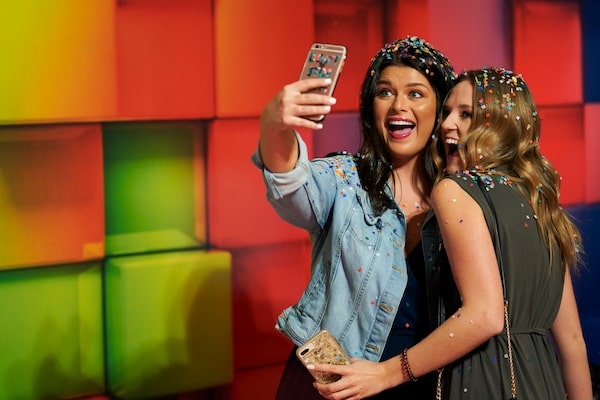
Visitors, their hair strewn with confetti, take selfies at a preview event for Candytopia in Dallas. Candytopia's highly Instagrammable pop-up art installations have also come to Houston and Atlanta.Cooper Neill/Getty Images for Candytopia
Cliff Lauson is senior curator at the Hayward Gallery in London.
Around a decade ago, while abroad, I remember attending my first social-media-specific press viewing for an art exhibition. It was held in the evening, there was a DJ, sushi and cocktails – this was not a normal press viewing. The museum definitely had “young and hip” in its event brief. What was fascinating was that, unlike normal art critics, who dutifully carry around branded press folders and small notebooks, listen politely to speeches and generally stay within their own private thoughts (lest another journalist steal their critical take on a show), these influencers were actually very social with each other. They helped to set up and pose for each other’s photos. They shared tips on lighting, angles and which lenses to use. They brought props. And they weren’t actually that interested in the sushi – or the art, for that matter.
Nowadays, 10 years later, I’ve been having multiple cases of déjà vu. People I see at the start of my visit to an exhibition, posing in front of artworks to have their pictures taken, seem to be appearing later the same day, still in the galleries, still posing, sometimes in front of the same artworks, but wearing entirely different clothing. This behaviour is increasingly common, I am reliably informed by gallery docents: These guests pack a few sets of clothes, change in the bathrooms and then spend hours trying to take the perfect snap for Instagram. They’re not press influencers; they’re just digital natives out to take some good photos to post on their feeds.
As a curator, I find these related observations curious, if a little disturbing. These two different types of gallery-goers are clearly interested in creating something that relates to the art on display, but is not about the art per se. They’re after high-impact images that will circulate well and attract likes and followers.
The recent spate of so-called museums sprouting up around the world, such as the Museum of Ice Cream, Toronto’s Eye Candy and Museum of Illusion, the Color Factory, Egg House, Candytopia, Dream Machine and Happy Place are also reflections of this shift. These high-energy attractions are filled with themed decor, luminescent colours and interactive props, and have been seemingly designed to facilitate the perfect Instagram photo-op. As the social-media network has grown in popularity, the ways in which it connects people to art and visual culture have also become more diverse: as a travel gateway, living archive, metric for success, marketing platform and even an aspirational addiction.
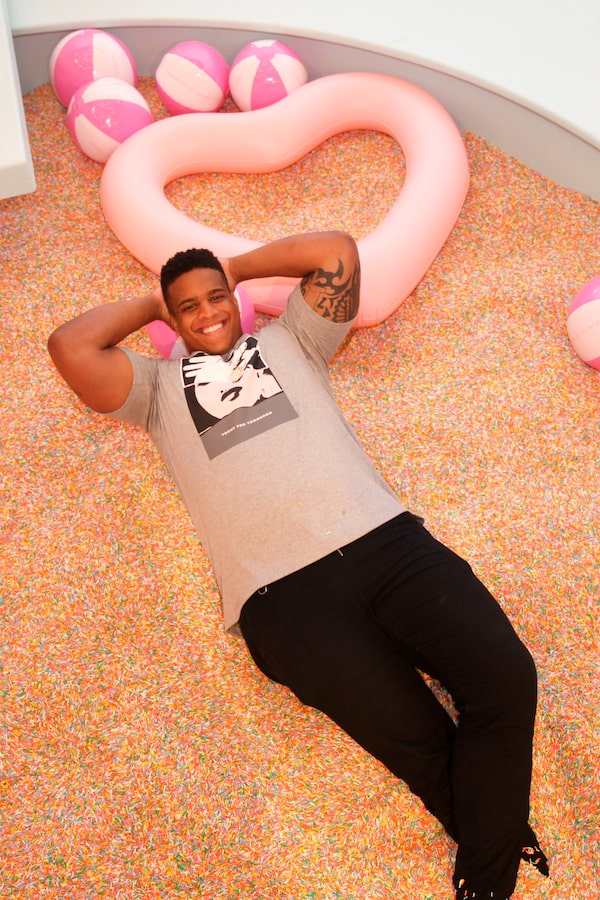
At San Francisco's Museum of Ice Cream, former Patriots defensive lineman Corey Lewis has fun in the sprinkle pool.Kelly Sullivan/Getty Images for Museum of Ice Cream
More than other social networks, Instagram suits the field of art. Its retro-styled square format and creative filters befit the image-centric artworld, and its long text fields have informative potential – like descriptive captions – and also scope for the opinions, anecdotes and musings of the user. I’d even suggest that emojis are a part of this visual appeal, being a kind of pictorial language on their own. With over a billion users, Instagram’s reach is both wide and pervasive.
In the early days of social media, museums feared that allowing unrestricted photography of their collections would mean that people would view artworks on screens from the comfort of their own homes, causing footfall to plummet. Those fears turned out to be largely unfounded and, to the contrary, just as people flock to see what others are looking at, they also do what others do. What now comprises an “audience engagement” strategy can actually increase attendance. Museum collections and temporary exhibitions no longer have photography restrictions, and hashtag signage is usually prominently placed, allowing all of the shared content to be monitored and summarized in graphs and infographics. Most institutional Instagram channels are run by marketing or communications staff who analyze these statistics, and in turn aim to improve them by convening the aforementioned social-media gatherings, as well as extending invitations to influencers to attend, respond to or collaborate on projects. This self-perpetuating economy of sharing then leads to a competitiveness across organizations in the endless pursuit of more likes.
Large amounts of personal or inferred data about users enables Instagram to provide highly targeted advertising, and museums, like everyone else, take full advantage of this service. For cash-strapped public organizations, social-media marketing is actually a more cost-effective way to reach intended audiences than more traditional advertising formats such as newspaper or poster campaigns. Advertising revenue is of course the other half of the sharing economy, and is highly profitable for Instagram and its parent company Facebook.
A recent article showed that music-streaming services that pay artists per play are actually causing a change in the structure of pop music, as musicians and producers optimize tracks to achieve high play counts. Songs are becoming shorter and intros are disappearing in favour of punchy chorus lead-ins to engage listeners before they swipe on to the next track. In the same way these streaming services are actually changing the type of content produced, the phenomenon is also happening in the visual sphere, with a new kind of experiential visitor attraction growing up around Instagram. These destinations, such as @museumoficecream or @wearehappyplace, go into interior-design overdrive, bringing together immersive, hypercolour themed rooms for the sole purpose of being ‘grammed.
Inside these 21st-century playgrounds for image-conscious adults, one does not find rides or games, but instead a series of environments and installations which serve as scenes and backgrounds for photos. The Museum of Ice Cream, which opened in New York in 2016 (and is now in San Francisco) is generally attributed as being the first of these venues, and featured giant popsicles, a banana room and a sprinkle pool, mostly co-ordinated in shades of pink . Since then, dozens of insta-museums have opened around the world – permanent, pop-up and travelling. In Toronto, HideSeek’s installations are meant to "to make you feel like a kid again,” while Eye Candy lets you take aspirational photos in a room set up to look like a private jet. Insta-museums are set for maximum optical stimulation with interactive elements: Pirouette inside an oversized snow globe, get dizzy in a mirror maze or dive into a pool-sized ball pit.
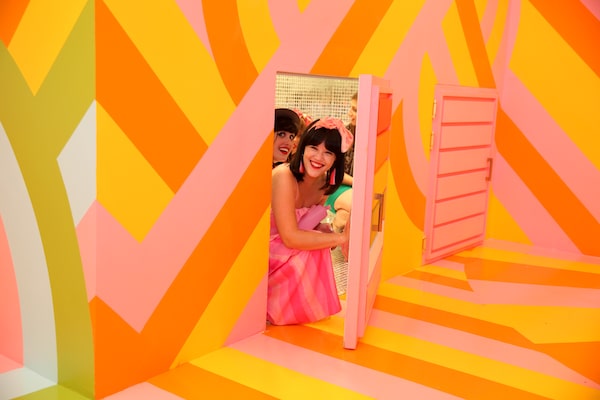
San Francisco, 2017: Visitors enjoy the opening party of the Museum of Ice Cream. The brightly coloured exhibit started as a pop-up in New York a year earlier.Kelly Sullivan/Getty Images for Museum of Ice Cream
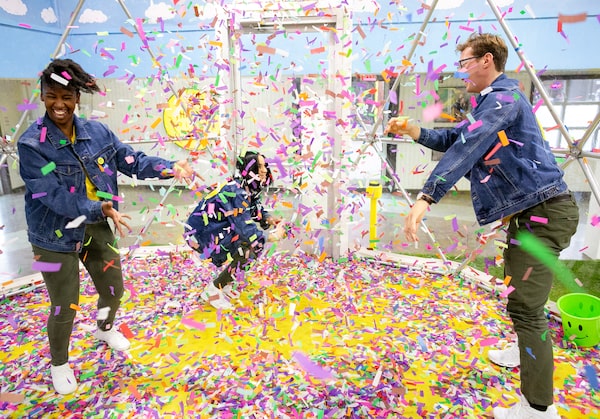
Toronto, 2018: Staffers Karlena Waugh, Yennifer Diaz and Greg Blackmore demonstrate the confetti room at The Happy Place the day before the immersive exhibit's opening at the Harbourfront Centre.Melissa Tait/The Globe and Mail
Houston, 2019: At the opening preview for Houston's Candytopia exhibit, candy reproductions of famous works of art, from Leonardo da Vinci's Mona Lisa to August Rodin's The Thinker, line the walls around a candy sphinx.Bob Levey/Getty Images for Candytopia
While there’s plenty of fun to be had, there’s also a certain amount of anxiety induced by trying to look like you’re having as much fun as everyone else on the venue’s Instagram channel. What these often self-labelled museums lack is a sense of autonomous thought and critical-mindedness. To be fair, they don’t propose to be galleries of contemporary art, nor aim to replace “traditional” museum and gallery spaces.
The experience that insta-museums offer is perhaps actually not such a new idea; not unlike a prop-filled turn-of-the-century portrait studio, they provide imaginative and surreal backdrops for staged photographs. Instead of wearing formal attire and pretending to board a steamer to cross the Atlantic, people today stick their heads through a giant pizza-slice cutout that stands in a landscape of toppings and mozzarella. These attractions are also there to make money – a number of pop-up experiences are themed according to a sponsoring brand’s identity and are heavily badged with company logos and hashtags. Theirs is an act of consumptive reification rather than one of enquiry – of entertainment and not art. Recently, I was bowled over to discover that one venue in New York charges US$40 admission – substantially more than the much-maligned entrance fee of the Museum of Modern Art.
The combination of late capitalism and a culture of aspiration has led to the privileging of experience, what business entrepreneurs B. Joseph Pine II and James Gilmore called “the Experience Economy.” As they saw it, this consumer-focused epoch evolved out of the service economy, with successful businesses borrowing from theatre to stage and perform their products in order to generate an emotional response in the consumer. Mr. Pine and Mr. Gilmore published their book The Experience Economy back in 1999 – the iPhone hadn’t been invented yet, and social media was still in its infancy. Twenty years on, much of what they proposed or foreshadowed is fully in evidence on Instagram: from acrobatic yoga poses (#yogaeverydamnday) to humble-brag beach vacations (#sorrynotsorry) to gratuitous shots of well-presented entrées (#foodporn). If the Experience Economy relies on theatricality, then with each post a user performs a glimpse of their online persona, sending #FOMO waves of jealousy rippling through the ether.
Visitors pose at Vinyl Museum in Tokyo in 2018. The museum was designed to attract young women who are interested in taking pictures of themselves with the installations and uploading them to social media, the art director of the museum said.Kim Kyung-Hoon/Reuters
In the art world, Instagram has become the social-media platform of choice for artists, curators and collectors because its strengths as a digital network reinforce and extend the conversations across global networks. Like the internet in general and all social-media platforms, it connects people, but it also does so visually. You can see art from remote places and keep track of different exhibitions, biennials and fairs that either are too great in number or involve too big a jet-setting carbon footprint to attend. You can gain insight into an artist’s practice or their production and, as the platform is relatively mature, you can search an incredibly vast image and video archive using hashtags. Instagram also maintains a relatively democratic ethos, allowing anyone with a smartphone to join and participate, giving individual artists and curators voices alongside the institutions of art.
But as a curatorial research tool, Instagram is also hampered by its nature as a social network. Content is rapid-fire and – once you’ve double-tapped “like” on a particular image – is also pretty much disposable. Just as you wouldn’t use Google Images to research an exhibition, Instagram tends to attract a certain type of user-generated content based on likes, hashtags and followers. Most of the time, posts are images which look spectacular or ridiculous or humorous, even more so with photo filters (including bunny ears). It’s hard to find a moment of concentration among the infinite scroll of visual hyperbole. Unlike Pinterest, the social network popular for grouping images onto virtual mood boards and sharing them, Instagram is geared toward the incessant production of new content, rather than how content can be productively organized and made relevant.
Worse still, in 2016, the year Instagram overtook Twitter in popularity, it introduced an algorithm for “personalizing” content for users. Instead of displaying images in the reverse chronological order of their posting: “the order of photos and videos in your feed will be based on the likelihood you’ll be interested in the content, your relationship with the person posting and the timeliness of the post.” If content bias wasn’t already inherent in the social network, this change formalized an echo chamber – posts by the people one follows are not treated equally. Instagram is curating our feeds. Thus, the potential for making new discoveries is increasingly minimal. If I’m looking for emerging artists and unique artworks – precisely what my friends, peers and social circle are not looking at – my filter bubble basically excludes any chance of serendipitous discovery.
But isn’t there a whole generation of artists making Instagram art? It’s true that numerous artists have a social-media presence and some may have even found influencer levels of success by obtaining large numbers of followers. However, most artists aren’t interested in making their actual artwork (as opposed to images of it) contingent on a digital platform owned by a private multinational corporation, never mind the conservational considerations of maintaining the 2019 hardware and software to run it. Only five years have passed since the term “postinternet art” was coined and it has already fallen out of use, even though the ideas behind it – art made about the effect of the internet – are increasingly relevant, if normalized. Amalia Ulman (@amaliaulman) is probably the best-known artist to have made artwork on Instagram that has also become a photographic success in the physical gallery. But as a kind of behavioural ready-made that replicates a widespread behaviour on the app, her voyeuristic selfies emulate the kind of fictive malaise of aspirational posting. Forget postinternet – it seems we’re still stuck in postmodernism.
While some people say we live in an age of screens, I actually think the age we live in has less to do with surfaces. Screens on their own are just black glass, just an interface; it’s the relationships and experiences they facilitate that matter. Art is about how we relate to each other and the world around us; if social media is the 2010s version of these relationships, then of course it has a place in and around art. Artists have always been concerned with the viewer’s experience of the artwork, and they are of course the first viewers of their work. How a visiting public experiences artworks and what they choose to interact with (and take photos of) might be beyond the artists’ control. The question for museum curatorial and programming teams is how to successfully balance artistic integrity with popularity, how to lead rather than follow.
In an age of increasing inattention, what the museum offers is a space of solace. This is sometimes a space for contemplation and appreciation, but can also be a space for social change. What I love about experiencing art is its potential for challenging how we think about the world; it’s not necessarily something that you (double-tap) like. You also can’t experience this while you’re picking which filter to use or trying to fix the auto-correct of an artist’s name as hashtag. On average, a museum or gallery visitor spends a shockingly quick 15 to 30 seconds looking at an artwork, while an Instagram post surely scrolls past in less than a second. I think that alongside our most immersive and experiential exhibitions, museums should also offer a device-free day – to encourage people to look closer and with sustained attention, even if for a few more seconds.
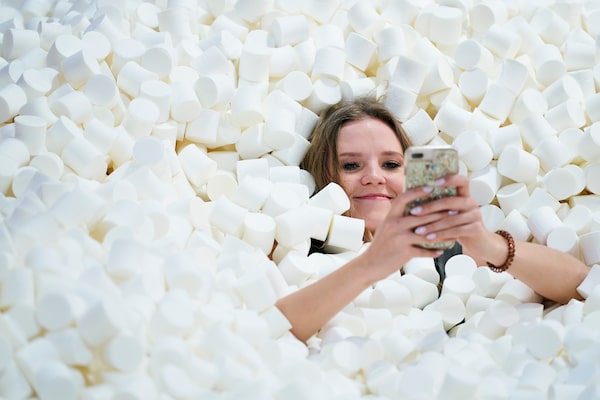
A visitor takes a selfie at Candytopia's opening preview event in Dallas.Cooper Neill/Getty Images for Candytopia
Keep your Opinions sharp and informed. Get the Opinion newsletter. Sign up today.